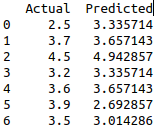To predict the dependent variable for the corresponding independent variable using python.
Import necessary libraries.
Load the sample data set.
Assign the independent(X)and dependent(y) variables.
Train our data set in 70:30 manner.
Pass the X_train and Y_train in to the linear model.
Predict Y according to X.
#import the libraries
import pandas as pd
from sklearn.model_selection import train_test_split
from sklearn.linear_model import LinearRegression
#Sample data set
data={‘age’:[25,26,25,23,30,29,23,24,26,25],
‘rating’:[4,3.6,2.5,2.25,4.5,4.4,3.9,3.5,3.7,3.2],
‘bonus’:[1300,1400,1250,1100,1500,
1450,1150,1100,1250,1200],’salary’:[2500,
2600,2400,2200,3000,2900,2300,
2200,2450,2350],}
#create data frame
df=pd.DataFrame(data)
#Measuring descriptive statistics
print(df.describe())
#Take independent variable
X = df.iloc[:, :1].values
#Take dependent variable
y = df.iloc[:, 1].values
#Train our data
X_train, X_test, y_train, y_test = train_test_split(X, y, test_size=0.7, random_state=0)
#building linear model
regressor = LinearRegression()
#Fit the variable to the linear model
t=regressor.fit(X_train, y_train)
#print the linear model results
print(“Regression intercept is\n”,regressor.intercept_)
print(“Regression coefficient is\n”,regressor.coef_)
#make the predictions
y_pred = regressor.predict(X_test)
df1 = pd.DataFrame({‘Actual’: y_test, ‘Predicted’: y_pred})
#print the prediction as data frame
print(df1)


